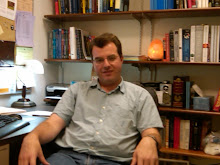I'm almost done with selections from "Two New Sciences." This is mostly about falling objects, buoyance, pendulums, and solid mechanics. It's well-argued, but it doesn't pack the same philosophical punch as "Dialogue Concerning the Two Chief World Systems." That's fine--the subject matter doesn't lend itself to the same philosophical punch. I view "Two New Sciences" as a book that physicists should challenge themselves with (and I intend to take up that challenge by getting the whole thing and reading it cover-to-cover at some point). If you really get Newtonian mechanics, you'll get "Two New Sciences." On the other hand, I view "Dialogue Concerning the Two Chief World Systems" as a matter of historical and cultural literacy, being a book that sparked an infamous episode in the history of science and religion, and also brought about a fundamental transformation of how the Western world sees the universe. I intend to plug that gap in my literacy by re-reading it at some point. When I read it several years ago it was a hard slog, but now that I've digested some excerpts and contemporary documents with annotation, I'm ready to try again.
Next book blogging project to be announced soon.
Tuesday, July 28, 2015
Sunday, July 26, 2015
Everybody must have stones
I'm reading Chapter 10, excerpts from Two New Sciences (published in 1638, while he was under house arrest). I like his argument for free fall speed being independent of the mass of the object: If we take a heavy and light stone and tie them together, then the small stone should retard the large stone while the large stone drags the small stone along, so they should go at a pace intermediate between their "natural" rates. However, they also form one large composite stone, and the larger stone should go even faster. So we get a contradiction.
Unfortunately, this argument is not entirely correct. If we drop the stones from a sufficiently tall building or cliff, they will reach terminal velocity (due to air resistance) and then the larger stone will indeed go faster (if they have the same shape). However, if we tie them together then the resulting speed will depend on both the increased mass (which, all else equal, will increase the speed) and the new shape (which could potentially increase the drag force).
However, Galileo's argument is sufficient to show that a model that only considers mass, to the exclusion of all other variables, is indeed defective. It just isn't sufficient to show the universality of free fall.
I first came across this argument a very, very long time ago, back when dinosaurs roamed the earth and Pets.com was a good buy and I was in grad school. I read Jacob Israelachvili's book on intermolecular forces, and he included Galileo's argument in the first chapter, along with an assertion that the argument is wrong, but he left it as an exercise for the reader to figure out why the argument was wrong. It took me a while to figure out the problem with the argument.
Subscribe to:
Comments (Atom)


